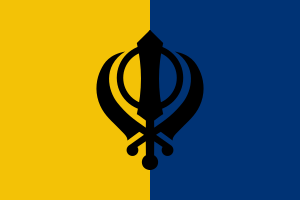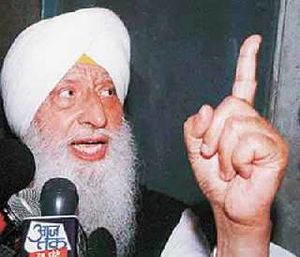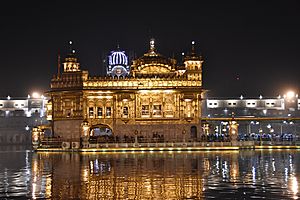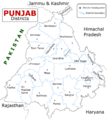Khalistan movement facts for kids
The Khalistan movement is a political Sikh nationalist movement that wants to create an independent state for Sikh people, inside the current North-Western Republic of India. Such a state existed in Punjab from 1709 to 1849. It was called the Sikh Empire.
Historical Sikh empire had it's Capital in Lahore, Pakistan. Most of historical Sikh empire is now part of Pakistan. Lahore, Multan, Peshawar and Kashmir. The new state created would be called Khalistan in the modern territories of East Punjab and Himachal Pradesh. Its capital would be Chandigarh or possibly Amritsar.
Background
The movement was most popular in the 1970s and 1980s. Today, it is seen on a smaller scale. There are claims that the movement supports young people financially, if they join militant groups fighting to get a Sikh homeland. Most of this funding comes from Sikh supporters outside the current state of India.
On April 12, 1980, Jagjit Singh Chauhan, a prominent supporter of the movement, met with Indira Gandhi. After the meeting, he declared that he had formed the National Council Of Khalistan, at Anandpur Sahib. He said he was the President of this movement, and Balbir Singh Sandhu was its Secretary General. In May 1980, Chauhan travelled to London and announced the formation of Khalistan. A similar announcement was made by Sandhu, in Amritsar. Sandhu also released stamps and currency of Khalistan.
Important events and issues
In the 1980s, some supporters of the movement responded to oppression with violence. The Indian Army reciprocated the violence. In one such incident, the Indian Army forced their way into the Harmandir Sahib, also known as the Golden Temple. The Indian Government was criticised for how they handled the operation, which resulted in deaths to both parties, and damage to the Temple.
Many Sikhs say that the Indian Government desecrated the holiest Sikh shrine. Indian Prime Minister Indira Gandhi was assassinated by her two Sikh bodyguards, and many thousands of Sikhs were massacred in the following riots. In January 1986, the Golden Temple was occupied by militants of the All India Sikh Students Federation and Damdami Taksal.
On 26 January 1986, the gathering passed a resolution favouring the creation of Khalistan. The people in favor of Khalistan said it should become a Sikh-majority state.
The Constitution of India says it is forbidden to make new states which are independent of India. Different groups in favor of Khalistan fought an insurgency against the government of India. Indian security forces suppressed this insurgency in the early 1990s. Since then, little has been done inside Punjab to get a Sikh state, but certain organisations in favor of Khalistan, such as Dal Khalsa (International) are still active outside India.
Images for kids
-
Maharaja Ranjit Singh's Sikh Empire at its peak in c. 1839 most of which is currently under Pakistan
-
British Punjab Province, in 1909
-
Map of the present-day Indian state of Punjab. Following the partition, East Punjab became PEPSU, which was further divided in 1966 with the formation of the new states of Haryana and Himachal Pradesh as well as the current state of Punjab. Punjab is the only state in India with a majority Sikh population.
-
The pro-Khalistan Sikh separatists within the Harmandir Sahib were led by former Major General Shabeg Singh
See also
 In Spanish: República Federal de Jalistán para niños
In Spanish: República Federal de Jalistán para niños











